Genetics 2B
The Complementary Sex Determiner (csd) Gene - Sex Alleles
Honey bees along with other Hymenoptera (insects - wasps, ants, sawflies) do not have a sex chromosome. A chromosome based sex determining system (i.e. male and female progeny inherit genes from both parents) is not possible with these insects because the males inherit only a random half of the maternal genome while the females inherit both maternal and paternal genes.
The mechanism of sexual reproduction these insects use involves the complementary sex determiner (csd) gene. The name comes about when the two different genes (the sex alleles) at a single locus complement each other. This triggers a mechanism whereby the zygote develops into a female bee - the worker or queen. The drone has only one allele at the locus so no comparable mechanism is possible.
This csd gene consists of 1453 bases and encodes for an arginine-serine rich protein; different alleles produce very different amino acid sequences. The csd gene exists in at least 19 allelic variants in the honey bee; these are denoted as a1, a2, a3, etc.
Female bees (workers and queen) have two copies of the csd gene which are always different alleles - they are heterozygous;
males (the drones) have only one copy - they are homozygous.
Honey bees along with other Hymenoptera (insects - wasps, ants, sawflies) do not have a sex chromosome. A chromosome based sex determining system (i.e. male and female progeny inherit genes from both parents) is not possible with these insects because the males inherit only a random half of the maternal genome while the females inherit both maternal and paternal genes.
The mechanism of sexual reproduction these insects use involves the complementary sex determiner (csd) gene. The name comes about when the two different genes (the sex alleles) at a single locus complement each other. This triggers a mechanism whereby the zygote develops into a female bee - the worker or queen. The drone has only one allele at the locus so no comparable mechanism is possible.
This csd gene consists of 1453 bases and encodes for an arginine-serine rich protein; different alleles produce very different amino acid sequences. The csd gene exists in at least 19 allelic variants in the honey bee; these are denoted as a1, a2, a3, etc.
Female bees (workers and queen) have two copies of the csd gene which are always different alleles - they are heterozygous;
males (the drones) have only one copy - they are homozygous.
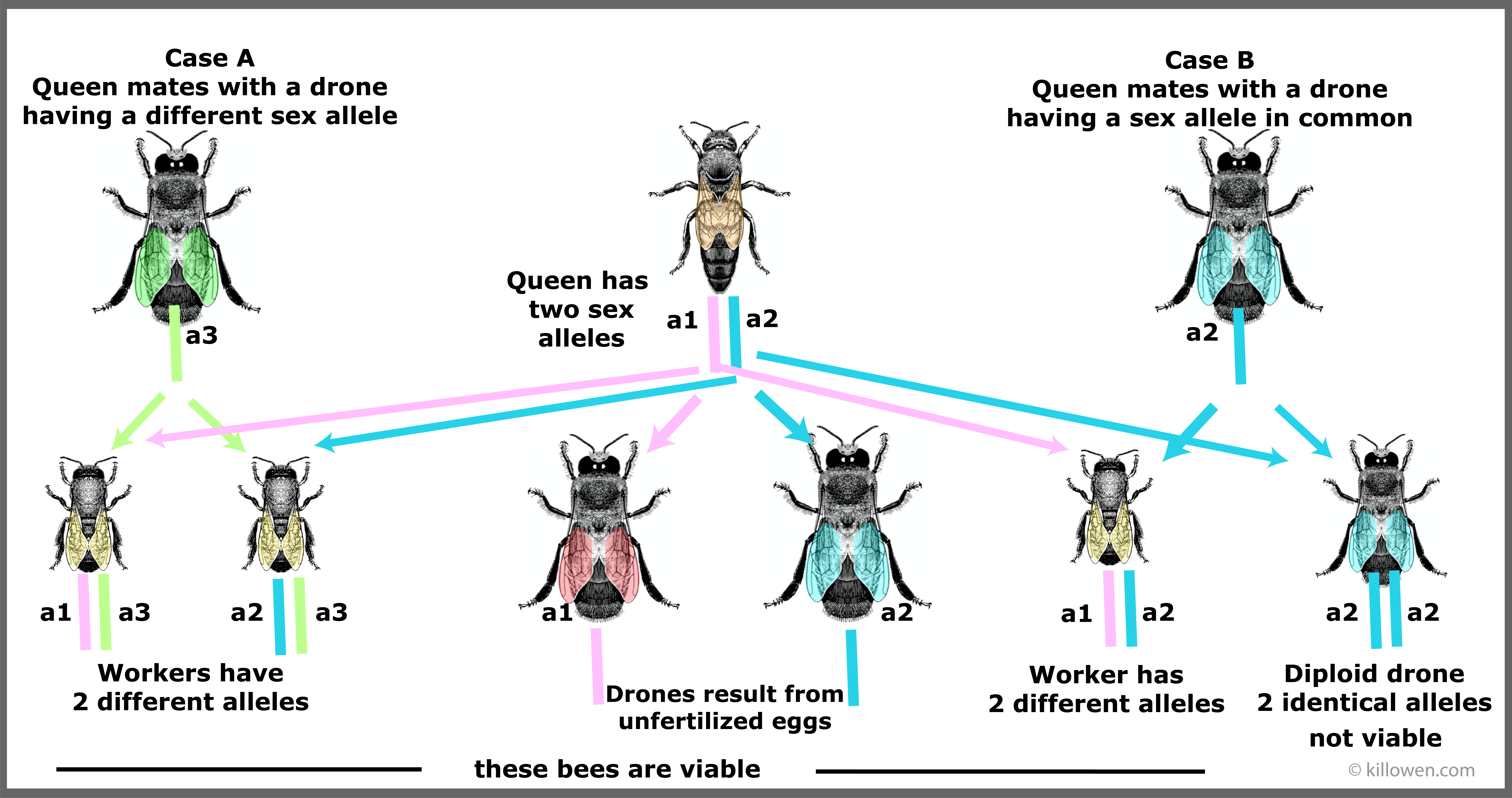
Pepperpot or Shot Brood
The external surface of all insects - the cuticle - is covered by a species-specific complex mixture of highly stable, very long chain hydrocarbons. An analysis of the cuticular substances present on the grubs of the worker, the drone, and the diploid drone has shown that 4 long chain alkanes are present namely: tricosane , pentacosane
, pentacosane  , heptacosane
, heptacosane  , and nonacosane
, and nonacosane  .
.
A fifth substance the terpenoid squalene is also present. The amount of each differs considerably in the three types of larvae. It is proposed that the worker bee is able to sense the difference in the composition of these 5 compounds in each of the 3 brood varieties and so to distinguish that of the diploid drone. In particular the amount of squalene is very high in the diploid drone compared to the drone and worker grub. The results give strong support that the cannibalistic behaviour of the workers towards the diploid drone larvae is based on these 5 cuticular sustances.
is also present. The amount of each differs considerably in the three types of larvae. It is proposed that the worker bee is able to sense the difference in the composition of these 5 compounds in each of the 3 brood varieties and so to distinguish that of the diploid drone. In particular the amount of squalene is very high in the diploid drone compared to the drone and worker grub. The results give strong support that the cannibalistic behaviour of the workers towards the diploid drone larvae is based on these 5 cuticular sustances.
Ref.Paper [27].
The external surface of all insects - the cuticle - is covered by a species-specific complex mixture of highly stable, very long chain hydrocarbons. An analysis of the cuticular substances present on the grubs of the worker, the drone, and the diploid drone has shown that 4 long chain alkanes are present namely: tricosane
A fifth substance the terpenoid squalene
Ref.Paper [27].
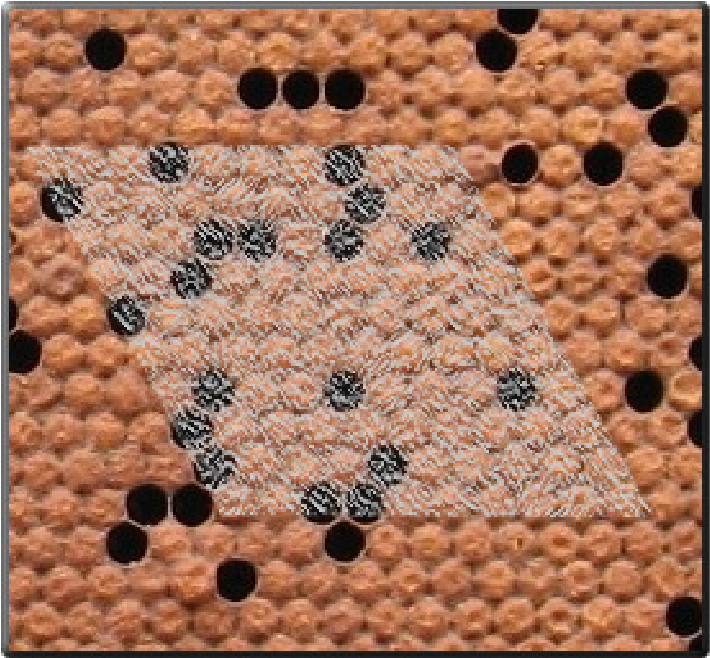
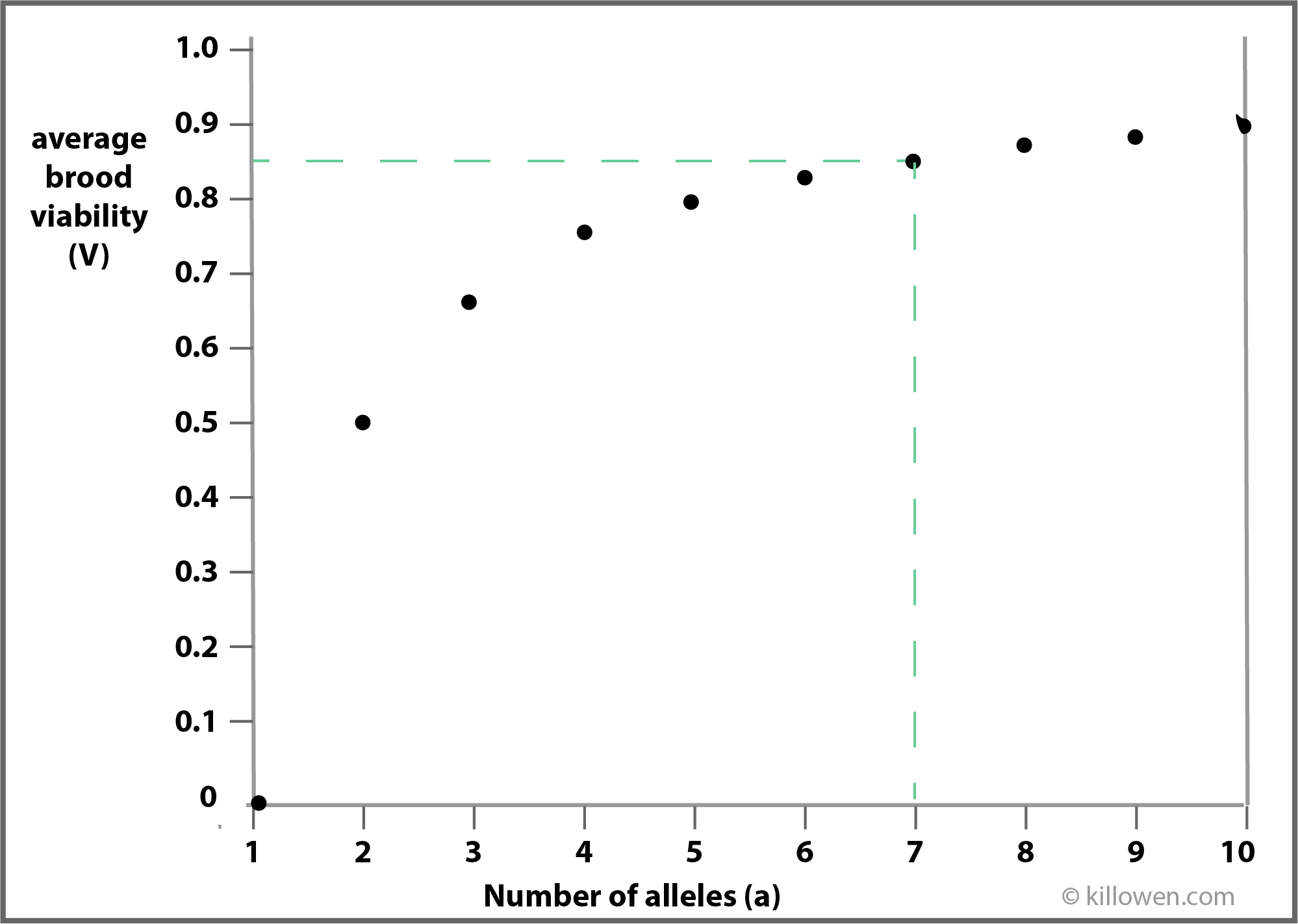
The apparent self-destructive behaviour of the diploid drone larvae would appear to be an evolutionary trait which helps to recycle nutrients. i.e. a diploid drone can neither reproduce nor contribute anything to the colony except its own body.
This results in so called pepperpot or shot brood i.e. where a larva has been removed by the workers an empty cell results.
Estimating the number of alleles in a colony
Following from the above the degree of pepperpot brood which might be expected will range from 0% in a colony where the queen has not mated with a drone with an allele in common, to 50% where the queen mated with only one drone having an allele in common.
The photo above shows a sample of pepperpot brood before the emergence of the bees. A rhombus with a side of 10 cells (i.e. it contains 100 cells) is placed over a typical sample of the new brood and the number of empty cells counted; in this case 18.
A correction factor might be considered to take into account the fact that empty cells could be found for reasons other than pepperpot brood. A factor of 6 is often quoted for a one year old queen. This then leaves 12 cells due to pepperpot.
The number of csd alleles in the colony (N) is now given by 100/12 = 8.33
This procedure is repeated on several other frames and the average number calculated.
This results in so called pepperpot or shot brood i.e. where a larva has been removed by the workers an empty cell results.
Estimating the number of alleles in a colony
Following from the above the degree of pepperpot brood which might be expected will range from 0% in a colony where the queen has not mated with a drone with an allele in common, to 50% where the queen mated with only one drone having an allele in common.
The photo above shows a sample of pepperpot brood before the emergence of the bees. A rhombus with a side of 10 cells (i.e. it contains 100 cells) is placed over a typical sample of the new brood and the number of empty cells counted; in this case 18.
A correction factor might be considered to take into account the fact that empty cells could be found for reasons other than pepperpot brood. A factor of 6 is often quoted for a one year old queen. This then leaves 12 cells due to pepperpot.
The number of csd alleles in the colony (N) is now given by 100/12 = 8.33
This procedure is repeated on several other frames and the average number calculated.
Sex alleles and the viability of the colony
How does the number of sex alleles carried by the bees in an apiary affect the viability of each colony?
In a paper published in 1982 by R. E. Page & R.W. Marks [29] it was shown shown that the average brood viability (V) in a population of honey bee colonies is a function of the number of csd alleles in the population is given by:

 V = 1 - 1/a
V = 1 - 1/a
where (a) is the number of alleles.
Looking at the graph on the left when there are 7 or more alleles there is over 85% average brood viability. Clearly it would be of benefit if at least this number of alleles could be maintained in the apiary.

How does the number of sex alleles carried by the bees in an apiary affect the viability of each colony?
In a paper published in 1982 by R. E. Page & R.W. Marks [29] it was shown shown that the average brood viability (V) in a population of honey bee colonies is a function of the number of csd alleles in the population is given by:
where (a) is the number of alleles.
Looking at the graph on the left when there are 7 or more alleles there is over 85% average brood viability. Clearly it would be of benefit if at least this number of alleles could be maintained in the apiary.
It is an interesting exercise to calculate the number of
heterozygous combinations (giving rise to a female bee) from an assumed population containing 19 alleles.
Mathematically this is given as:
 19!/(2!)(17!) = 171.
19!/(2!)(17!) = 171.
In the chart the number of heterozygous combinations for 19 alleles is 171,
for say 11 alleles this decreases to 55,
and for 6 alleles decrease further still to 15.
There are only 19 homozygous possibilities which result in drones.

Mathematically this is given as:
In the chart the number of heterozygous combinations for 19 alleles is 171,
for say 11 alleles this decreases to 55,
and for 6 alleles decrease further still to 15.
There are only 19 homozygous possibilities which result in drones.
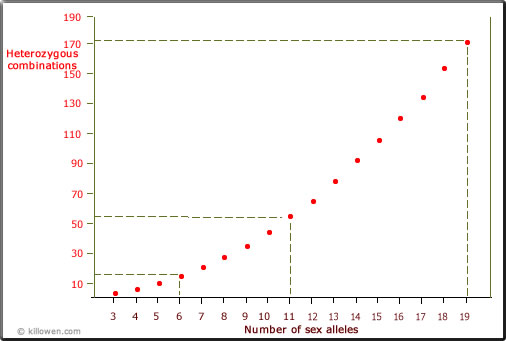
In the diagram a situation is shown for two cases A and B. In case A the queen mates with a drone having a different allele. The queen is diploid and has sex alleles a1 and a2; the drone is haploid and has allele a3. For a female bee to develop, the fertilized ovum or zygote must be heterozygous i.e. the allele combination must be different as in this example a1a3; a2a3.
In case B the queen mates with a drone which has an allele in common with the queen. The queen has two alleles a1 and a2 but the drone has allele a2. This result produces a worker having alleles a1a2 but an abnormal drone having allele a2a2 i.e. this drone with two identical alleles is diploid.
In case B the queen mates with a drone which has an allele in common with the queen. The queen has two alleles a1 and a2 but the drone has allele a2. This result produces a worker having alleles a1a2 but an abnormal drone having allele a2a2 i.e. this drone with two identical alleles is diploid.
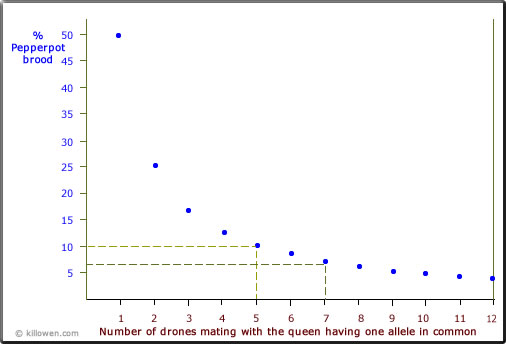
Theory and practice
The graph on the left shows a plot of what might be expected if a queen mated with a drone or drones having one allele in common. It is assumed that each allele combination is equally represented in the brood.
For example suppose the queen mated with 5 drones, then there are 10 possible heterozygous combinations of alleles. If however there is one allele in common then 1/10 of these combinations would be homozygous and so produce 10% pepperpot brood.
Similarly if the queen mated with 7 drones then there are 14 possible heterozygous combinations. In this case if there is one allele in common then 1/14 would be homozygous . The pepperpot brood would now be 7%.
Hence as quoted above:
number of csd alleles in a colony (N) =
 100/(% pepperpot brood)
100/(% pepperpot brood)

The graph on the left shows a plot of what might be expected if a queen mated with a drone or drones having one allele in common. It is assumed that each allele combination is equally represented in the brood.
For example suppose the queen mated with 5 drones, then there are 10 possible heterozygous combinations of alleles. If however there is one allele in common then 1/10 of these combinations would be homozygous and so produce 10% pepperpot brood.
Similarly if the queen mated with 7 drones then there are 14 possible heterozygous combinations. In this case if there is one allele in common then 1/14 would be homozygous . The pepperpot brood would now be 7%.
Hence as quoted above:
number of csd alleles in a colony (N) =
The greater the number of sex alleles the healthier the situation. However, the beekeeper wishing to develop a line of bees wants to breed from the best queen. If mating of the new queens takes place in the apiary, there is a high probability over time that the bees will become inbred. Clearly the same queen should not be used in successive years because the new queens produced in the second year could mate with drones produced by the queens from the first year i.e. they would have some alleles in common.
The best solution to this problem would be to allow the new queens to mate in another apiary where bees of a similar character are to be found. In the present state where feral colonies are no longer found owing to varroa, only the beekeeper can ensure that there is a sufficient mix of alleles present in the apiary. The minimum number has been estimated to be about 11 i.e. there are 55 heterozygous combinations. The beekeeper could ensure that this number is exceeded by bringing in new queens each year.
Winter survival of the colony has been found to be directly related to the number of alleles carried by the colony. If the number of alleles falls below the minimum, there is a greater chance the colony will not survive.
The best solution to this problem would be to allow the new queens to mate in another apiary where bees of a similar character are to be found. In the present state where feral colonies are no longer found owing to varroa, only the beekeeper can ensure that there is a sufficient mix of alleles present in the apiary. The minimum number has been estimated to be about 11 i.e. there are 55 heterozygous combinations. The beekeeper could ensure that this number is exceeded by bringing in new queens each year.
Winter survival of the colony has been found to be directly related to the number of alleles carried by the colony. If the number of alleles falls below the minimum, there is a greater chance the colony will not survive.